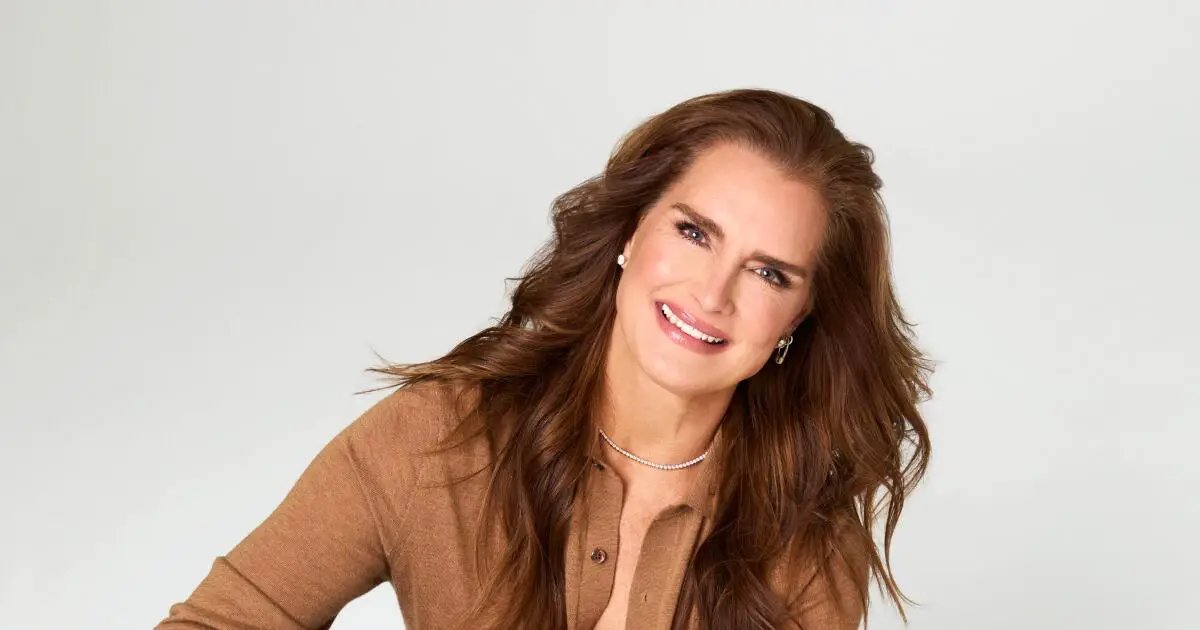It is a peculiar quirk of the British aristocracy that you can hold a title, such as the duke of Devonshire, and have no connection to the part of the country to which it is referring. The Devonshires – first earls and later dukes – do not reside in Devon. Past and present property includes Bolton Abbey in North Yorkshire, and Chiswick House and Burlington House in London . The jewel in the portfolio is Chatsworth: a magnificent Grade I-listed pile in Derbyshire, often described as one of Britain’s favourite stately homes. For those who have a lot of it, land becomes just another heirloom to be parcelled up, sold off, bequeathed and bounced down and around the generations, like a nice handbag or antique opera coat.
This summer, Chatsworth hosts Erdem: Imaginary Conversations, an exhibition exploring the influence of the late Deborah Cavendish, nee Mitford, former inhabitant and muse for the designer’s spring/summer 24 collection. Showcasing deconstructed ballgowns and bejewelled insects, the opening look is the funniest, a fraying tweed skirt-suit alluding to the Duchess’s love of derbyshire redcaps and Scots dumpies. Erdem says he wanted it to look “ravaged by chickens”.
Amusing as it is, this look epitomises the bizarre reverence the fashion world holds for the aristocracy. From the days of whimsical Tim Walker shoots in stately homes to Princess Anne-inspired Fendi garb, the visual codes and sprawling homes of the upper classes often grace mood boards and magazine pages. Part of the charm, at least as far as designers and photographers are concerned, seems to reside in that very posh combination of splendour and squalor – nodding to a world in which dishevelment can be read as blase unconventionality and quality matters but nothing is too precious; principles like “make do and mend” taking on a different, more aspirational tone when there’s an archive full of 19th century, hand-painted fabrics to raid.
On a simpler level, with their gowns and Capability Brown-designed gardens, the aristocracy satiate fashion’s taste for high fantasy: offering an approximation of a real-life fairytale, complete with tiara and castle (funny given that, just as many fairytales were edited to obscure their unpleasantness, the aristocracy are also expert at hiding dark, exploitative secrets beneath idyllic exteriors). However, much as it may seem self-evident why an industry that sells expensive clothes might decide to reference the historically rich and powerful, it’s troubling to see how easily the continued romanticising of inherited titles, inherited mansions and enormous inherited wealth – the average worth of a title has doubled post-financial crisis to reach £16m – serves as a form of soft propaganda, encouraging affection and even admiration for those who lucked out in the feudal order.
Known colloquially as Debo, the duchess of Devonshire spent half a century as Chatsworth’s chatelaine after marrying Andrew Cavendish in 1941. In 1981, ownership was transferred to the Chatsworth House Trust, a charity responsible for its upkeep and community reach – with the family paying market rent for their private quarters.
Over the decades, the duchess became a relatively beloved institutional figure: the epitome of the old school, no-nonsense posh girl with a much-mythologised childhood, who loved animals (unless they could be hunted), preferred to buy her clothes at agricultural shows (other than her bespoke Turnbull & Asser shirts in every colour), and, by being a lifelong Conservative, managed to achieve a veneer of neutrality compared to her sisters who numbered among them a Nazi (Unity) and a fascist (Diana, who was repeatedly pronounced Debo’s favourite).
In the exhibition, Erdem champions Debo’s ingenuity and indomitable English spirit, praising her business nous in reviving Chatsworth – selling off land, buildings and artwork to fund an unexpected £7m inheritance tax bill, she later set up ventures including a farm shop and farmyard – while riffing on all the staple references one might expect: Cecil Beaton portraits and glitzy jewels, dainty dancing slippers arranged next to sensible walking shoes.
Taken on its own terms it is a beautiful exhibition, particularly in the way it illuminates Moralıoğlu’s obvious delight in the research process. And going to Chatsworth does make you long, despite yourself, for ceilings vast enough to host murals of goddesses and kings. But look closer and Debo emerges as the poster girl for the still-influential interwar fiction of a ruling class on the brink of disappearance; their roofs and cardigans both full of holes, the old world in decline while the heating bills rise. This palatably decaying image, complete with tulle skirts in storage and an endless supply of valuable artwork and tapestries to be sold off in an emergency, lights up a weird nostalgia-synapse in the British psyche. It is the same part tickled by endless Brideshead Revisited and The Pursuit of Love remakes, in which the dream of the big house is counterbalanced by more relatable problems: chilblains, melancholy, emotional distance, the threat of obsolescence. But it’s worth remembering that in Debo’s case, the grand narrative is not one of triumph against the odds or any real threat of hardship, but something more akin to a princess who got to keep the palace.
Inspiration takes many forms, and designers frequently lean into invocations of imagined national character, toying with a blend of crude cliche and selective cultural history to form their idea of a certain kind of woman. French designers get understated chic, Italian designers sexy maximalism and so on. British designers often fall back on the idea of scrappy-around-the-edges eccentricity: a collision between monarchs and punks, pearls and hoodies.
Although this might suggest a more democratic class free-for-all, the subcultural or working-class aesthetic elements are often presented as ludicrous stereotype or tempering grit to the upper class fantasy – unsurprising in an industry where there are still a shocking number of titles and honorifics, and the golden age of working-class designers is far behind us. Previously, more interesting and provocative riffs on aristocratic codes came from the likes of Alexander McQueen, who grew up in east London and left school at the age of 16 when he was offered an apprenticeship on Savile Row, and Vivienne Westwood, who worked as a factory technician and a primary school teacher. But research from 2022 shows that the number of working-class people in Britain’s creative industries has shrunk by half since the 1970s to just 7.9%, while a recent report by Vogue Business flagged various systemic barriers to entry – expectations including endless unpaid labour at the start of one’s fashion career automatically excluding those who cannot afford to work for free, especially as the cost of living crisis continues to bite.
The posh continue to thrive. Scan the Peerage and you’ll see plenty of prominent fashion names, from models Cara Delevingne, Rosie Huntington-Whiteley, Jodie Kidd and Lady Jean Campbell to designers Serena Bute and Samantha Cameron. The Mitford sisters alone have been responsible for spawning a whole generation of models, editors, ‘It’ girls and stylists, fashion being an industry where connections and wealth don’t so much open the front door as offer the keys to the castle. In 2016, then-chief creative officer and CEO at Burberry Christopher Bailey described the Mitfords as “glam rock, military, wellies … a patchwork of things that I love” (which begs the question, given Unity and Diana’s politics, of which military?)
Burberry famously went through a period of image rebranding in the late 00s after its famous check started being worn by what some classed as “the wrong kind of people”: “chavs”. The answer was to reinvigorate an image of British heritage and idiosyncrasy, all mud on silk hems and tasteful trench coats. The results were often lovely to look at, but there was an underlying ugliness in the desire to shake off undesirable customers in pursuit of a higher class of clientele.
That’s the other reason why the aristocracy retains its innate thematic appeal: once able to dictate fashions and fads – Chatsworth was also home to the famed 18th century Georgiana, duchess of Devonshire, whose hairstyles became legendary – many of them are still likely to be customers.
In 1959, Evelyn Waugh wrote in an updated introduction to Brideshead Revisited, published 15 years previously, that it was “a panegyric preached over an empty coffin,” observing that “Brideshead today would be open to trippers, its treasures rearranged by expert hands and the fabric better maintained than it was by Lord Marchmain.”
The “cult of the country house” he identified then remains strong – Chatsworth is still monumentally popular, and Erdem’s exhibition will undoubtedly be a hit – but stronger still is the status of the aristocracy. Debo’s son Peregrine, the current duke of Devonshire, has an estimated net worth of £910m, occupying number 182 on this year’s Sunday Times rich list. This is unsurprising, given that it follows a general trend of extraordinary wealth consolidation among Britain’s peers via land ownership, asset management schemes, investments and more.
We might now be allowed to nose inside their grand halls and even take great pleasure in their frocks, but it is worth remembering that the aristocracy are not mere relics or enjoyably spirited stock characters – but active participants in a vastly unequal landscape.






